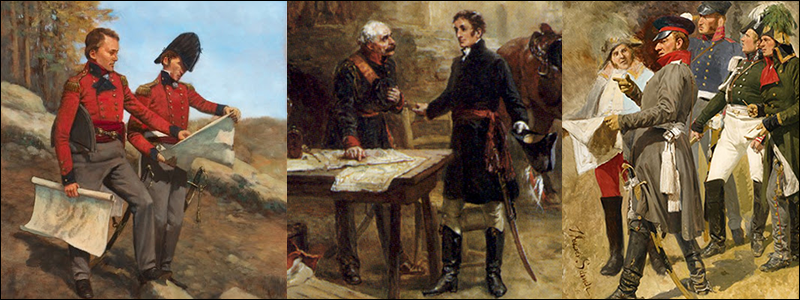|
Allied Training College (ATC) Coalition Library |
The Thin Red Line |
So, you`ve enrolled in the British Army and now you want to prove yourself in battle against the more numerous (and somewhat cocky) Frenchmen. If your battlefield of choice is Waterloo, then you`ve come to the right place. Hopefully this article will enlighten you as to how to defend successfully with the ragtag Allied Army until our Prussian friends arrive. You may ask what my credentials are? Well, I`m lowly Lt Mark Trowbridge (73rd Highlanders, 1st Division). I`ve only fought one battle in the NWC club - against Col Mark Adams (V Corps) but it was a major Allied Victory after 24 turns. Huzzah! For those of you who don`t know, I put together the Unofficial BGW Site about two and half years ago and my enthusiasm for the BG series is still going strong! I now playtest for John Tiller (BG Series designer). On to the important bit! I’ve heard from Allied Command that the French players seem to be favouring large-scale attacks against the Allied right flank so that’s what we’ll deal with here. (That’s the left hand side as you look at the map for those who maybe confused). This strategy of breaking the 3rd Dutch-Belgian Division, swinging around the allied flank and then hammering against the British II Corps can be extremely successful, there’s plenty of room for manoeuvre on the left - it’s also good cavalry ground and its the opposite side of the field from where the Prussians arrive. Remember its not always important to go for VP hexes. A wise Frenchmen can break the Allied flank and then take VP areas as he sees fit once the Allies are routed. So what can the Allied commander do to prevent this onslaught? Here are my humble suggestions: 1) Immediately shift the entire 3rd Dutch-Belgian Division to the area L’Estraye - Cambrai Farm. Preferably place your front line along the stream but with skirmishers from the light battalions deployed forward to Braine L`Alleud and on the road network. The latter will act as a tripwire should the French probe toward this flank. Keep your forward-deployed battalions in line formation (for max firepower) but remember to have at least a battalion or two from each brigade kept in reserve to act as a counter-attacking force should the enemy break through. Finally, keep both brigades in command/control whenever possible. These two brigades are very likely to rout quickly if disordered and acting independently. 2) Move the 3rd and 5th Cavalry brigades (1200+ troopers) into supporting positions but not on the front line. The II Corps and the 3rd D-B’s will need cav support to match the French cavalry that will undoubtedly accompany any enemy flanking move. With aggressive deployment of your cavalry you will be able to unnerve your opponent by slowing down his attack, forcing him to form square, bringing up his own cavalry etc. Anything that delays the enemy attack should be encouraged. 3) Ensure you have adequate artillery support on the high ground running from Mesnil Farm almost down to Hougoumont. 4 batteries should be enough for the job, with a horse artillery battery in reserve who can immediately deploy forward, unlimber and strengthen a threatened sector of the front. There’s nothing more annoying to a French commander than having his infantry columns suddenly threatened by a horse arty battery that came out of nowhere. 4) Keep at least half of the Brunswickers as a reserve to bolster both the 3rd Dutch-Belgians and the Brit II Corps should the French break through. Go for real defence in depth!! Follow the above four points to the letter and you will have accomplished this: An Allied Army fighting on interior lines (no longer strung out over 3-4 miles) allowing any enemy breakthrough to be quickly counter-attacked by all arms. Imagine your army with a tripwire perimeter that can dynamically shrink or expand depending on local conditions. If you can keep this perimeter well defended for 20+ turns then the Prussians will arrive and the French commander will have little chance of being victorious. Deploy all forces with reserves - here’s what I mean: Keep one battalion from each brigade a few hexes to the rear in column formation, one brigade from each Corps as a reserve (where permitting i.e. in this case the Brunswickers) and ensure all defences are combined arms operations - plenty of cavalry and artillery support. By the nature of the ground the French are more or less forced into a wide deployment from turn one and not many players shrink this down so as it becomes manageable. I often see the Young Guard or VI Corps being dispatched to the French right with the hope that they can hold the Prussians off - no way Napoleon - you’ll need more than that. Once the Prussians arrive in numbers then the French should really have already defeated the Allies. If they haven’t then c’est la vie. Well I hope my inane drivel has helped any new guys out there! Good luck! [Written by Mark Trowbridge as Published in the Napoleonic Wargaming Club (NWC) Newsletter]
|
Site Designed Maintained by Scott Ludwig & Walt Moehle (Coalition Army Webmasters) © 2005-Present September 19, 2024 7:29 AM |
